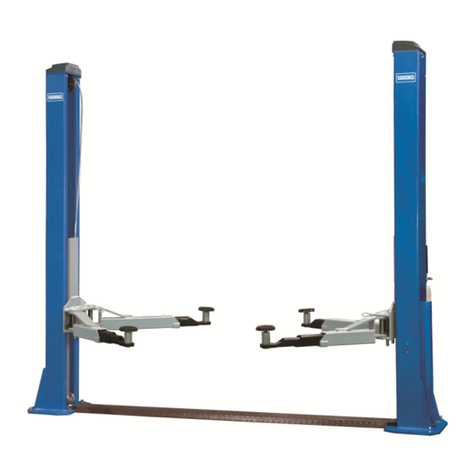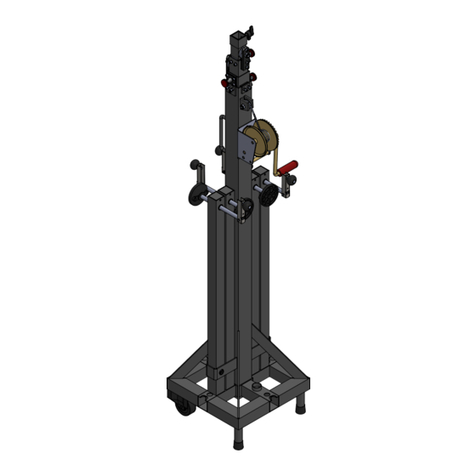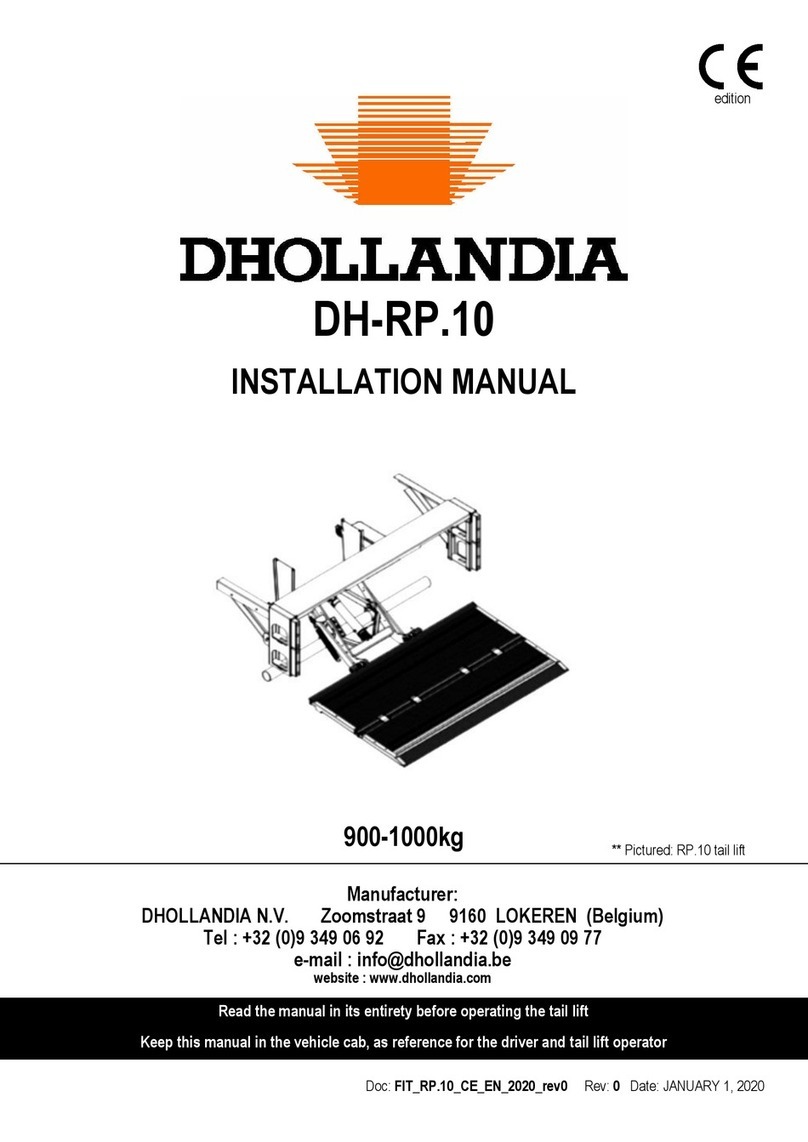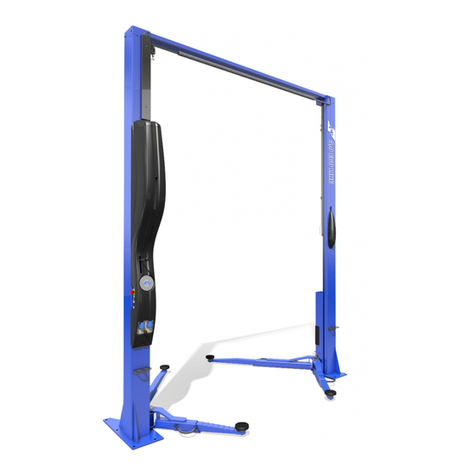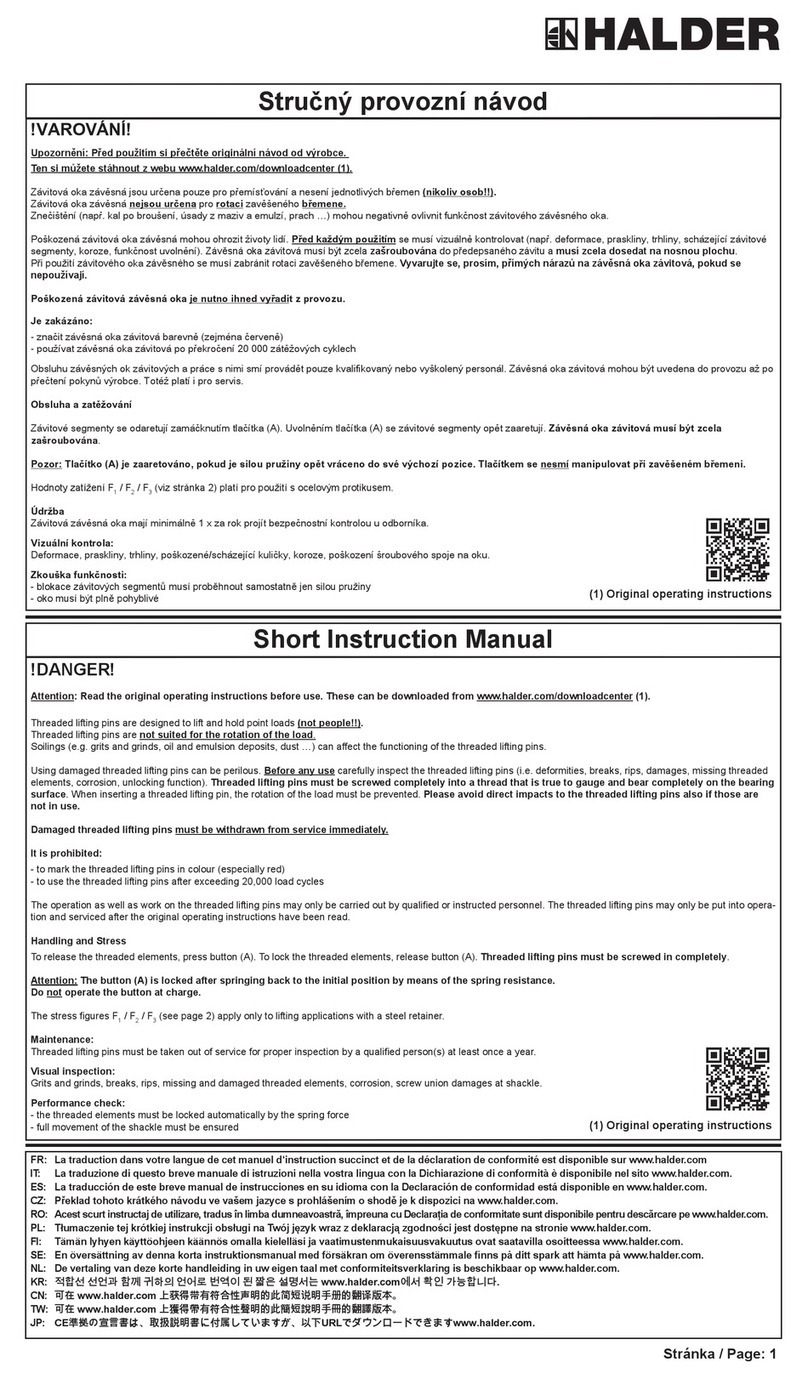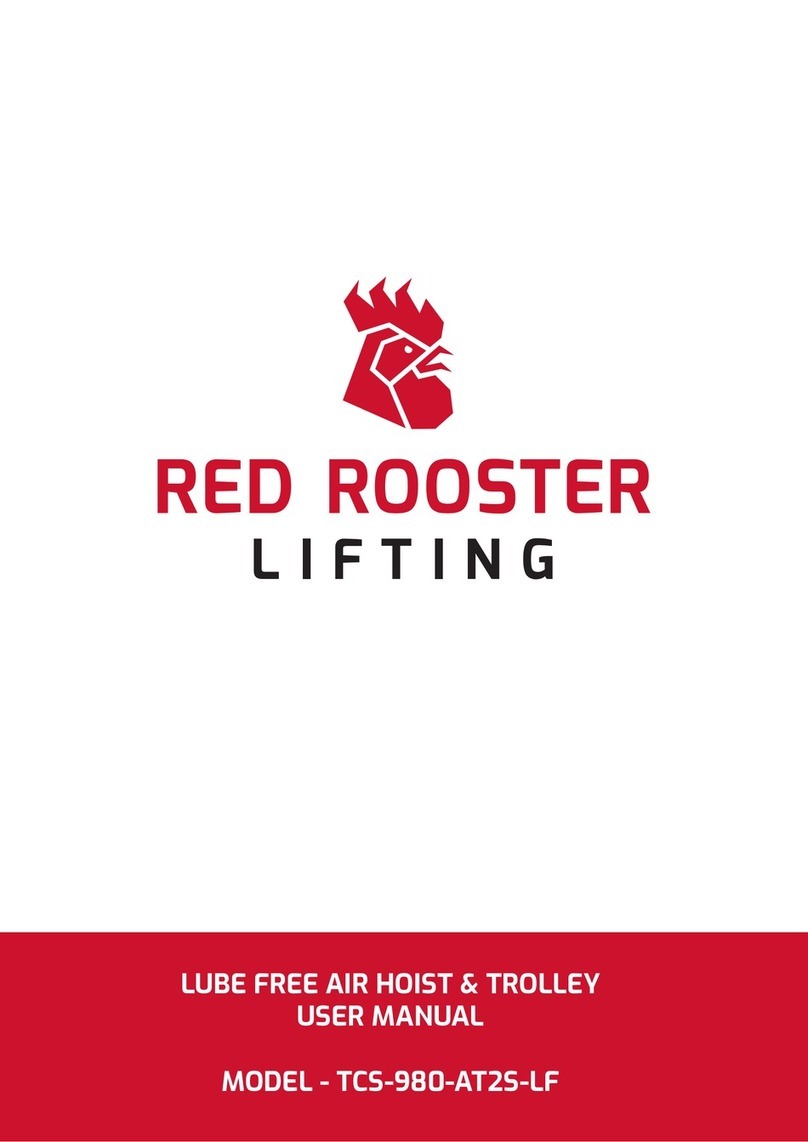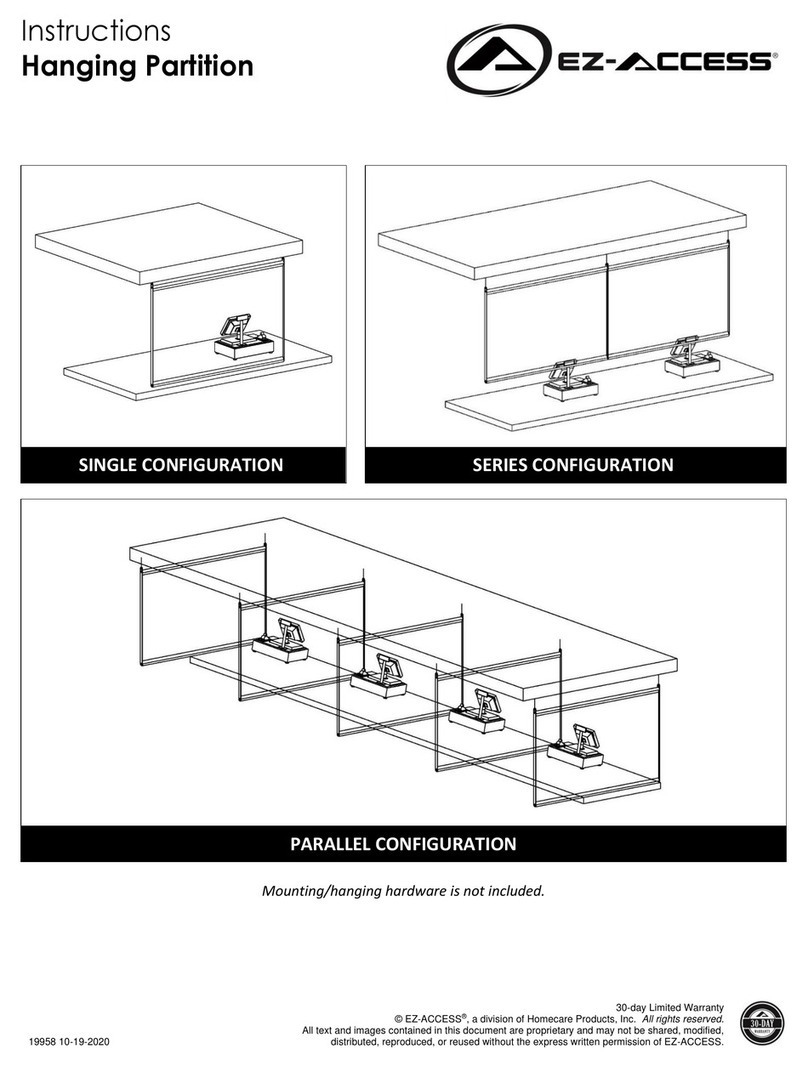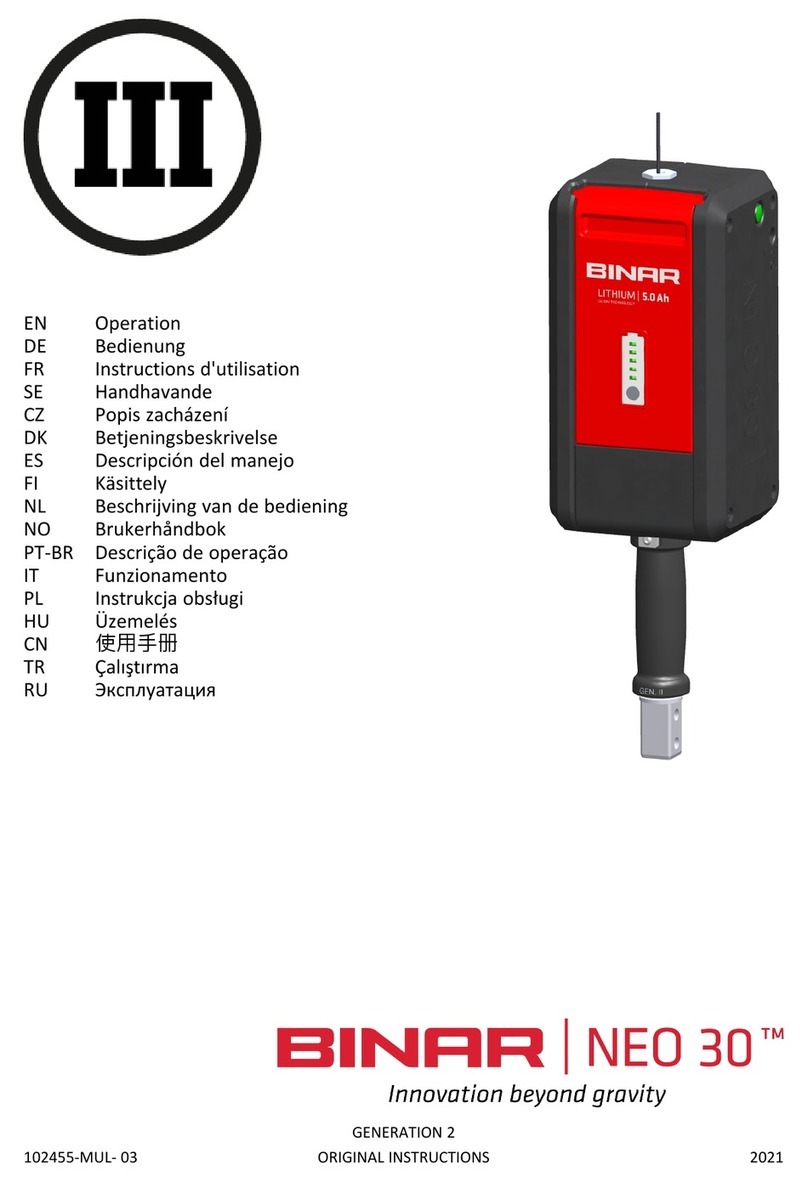Glomstad Motor GM - U95 PRO User manual

REV. 01 2020
1 / 28
USE
AND
MAINTENANCE
MANUAL
WHEEL BALANCER
WITH MICRO-PROCESSOR
GM - U95 PRO

REV. 01 2020
2 / 28
PRINTING CHARACTERS AND SYMBOLS
Throughout this m nu l, the following symbols nd printing ch r cters re used to f cilit te re ding:
Indic tes the oper tions which need proper c re
Indic tes prohibition
Indic tes possibility of d nger for the oper tors
BOLD TYPE
Import nt inform tion

REV. 01 2020
3 / 28
CONTENTS
1 INTRODUCTION
4
1.1 INTRODUCTION
1.2 MACHINE IDENTIFICATION DATA
1.3 MANUAL KEEPING
4
4
4
2 GENERAL INFORMATION
5
2.1 GENERAL SAFETY
2.2 STANDARD SAFETY DVICES
2.3 INTENDED USE
2.4 GENERAL CHARATERISTICS
2.5 MACHINE DESCRIPTION
2.6 TECHNICAL SPECIFICATION
5
5
5
5
6
6
3 TRANSPORTATION, UNPACKING AND STORAGE
7
3.1 TRANSPORTATION
3.2 UNPACKING
3.3 STORAGE
7
7
7
4 COMMISSIONING
8
4.1 SPACE REQUIRED
4.2 SHAFT ASSEMBLY
4.3 WHEEL GUARD MOUNTING
4.4 ELECTRIC CONNECTION
8
8
9
9
CONTROL PANEL AND MENU FUNCTION 10
5.1 DISPLAY PANEL
5.2 CONTROL PANEL
10
11
5.3 MENU FUNCTION 12
6 OPERATION OF THE WHEEL BALANCER 13
6.1 BASIC OPERATION INFORMATION
6.2 MOUNTING WHEEL ON SHAFT
6.3 WHEEL DATA ENTRY
6.4 BALANCING MODE
6.4.1 DYNAMIC MODE
6.4.2 STATIC MODE
6.4.3. STANDARD ALU MODE
6.4.4
☆
ALU MODE
6.4.5 SPLIT FUNCTION
6.4.6 UNBALANCE OPTIMIZATION (OPT)
13
13
15
16
16
16
17
18
20
21
7 SET UP 22
7.1 SELF-DIAGNOSIS
7.2 CALIBRATION
22
23
8 MAINTENANCE 26
9 ERRORS AND TROUBLE-SHOOTING
27
10 ACCESSORIES 28

REV. 01 2020
4 / 28
CHAPTER 1 – INTRODUCTION
1.1 INTRODUCTION
Th nk you for purch sing product from the line of wheel b l ncer. The m chine h s been
m nuf ctured in ccord nce with the very best qu lity principles. Follow the simple instructions
provided in this m nu l to ensure the correct oper tion nd long life of the m chine. Re d the entire
m nu l thoroughly nd m ke sure you underst nd it.
1.2 MACHINE IDENTIFICATION DATA
A complete description of the “Wheel b l ncer model” nd the “Seri l number” will m ke it e sier for
our technic l ssist nce to provide service nd will f cilit te delivery of ny required sp re p rts. For
cl rity nd convenience, we h ve inserted the d t of your m chine in the box below. If there is ny
discrep ncy between the d t provided in this m nu l nd th t shown on the n me pl te fixed to the
wheel b l ncer, the l tter should be t ken s correct.
1.3 MANUAL KEEPING
For proper use of this m nu l, the following is recommended:
• Keep the m nu l ne r the lift, in n e sily ccessible pl ce.
• Keep the m nu l in n re protected from the d mp.
• Use this m nu l properly without d m ging it.
• Any use of the m chine m de by oper tors who re not f mili r with the instructions nd
procedures cont ined herein sh ll be forbidden.
This m nu l is n integr l p rt of the m nu l: it sh ll be given to the new owner if nd when the
m chine is resold.
The illustrations have been made out of prototypes pictures. It is therefore
possible that some parts or components of standard production differ from those
represented in the pictures.
TO THE READER
Every effort h s been m de to ensure th t the inform tion cont ined in this m nu l is correct, complete
nd up-to d te. The m nuf cturer is not li ble for ny mist kes m de when dr wing up this m nu l nd
reserves the right to m ke ny ch nges due the development of the product, t ny time
LOGO
Type:
Volt Amp Kw
Ph Hz
Ye r of m nuf cturing:

REV. 01 2020
5 / 28
CHAPTER 2 – GENERAL INFORMATION
2.1 GENERAL SAFETY
• The wheel b l ncing m chine should only be used by duly uthorized nd tr ined personnel.
• The wheel b l ncing m chine should not be used for purposes other th n those described in the
instruction m nu l.
• Under no w y should the wheel b l ncing m chine be modified except for those modific tions
m de explicitly by THE MANUFACTURER.
• Never remove the s fety devices. Any work on the m chine should only be c rried out by
speci list personnel.
• Avoid using strong jets of compressed ir for cle ning.
• Use lcohol to cle n pl stic p nels or shelves (AVOID LIQUIDS CONTAINING SOLVENTS).
• Before st rting the wheel b l ncing cycle, m ke sure th t the wheel is securely locked on the
d pter.
• The m chine oper tor should void we ring clothes with fl pping edges. M ke sure th t
un uthorized personnel do not ppro ch the m chine during the work cycle.
• Avoid pl cing objects inside the b se s they could imp ir the correct oper tion of the m chine.
2.2 STANDARD SAFETY DVICES
• Stop key for stopping the wheel under emergency conditions.
• A wheel gu rd of high imp ct pl stic th t is designed to prevent the counterweights from flying
out in ny directing except tow rd the floor.
• A switch interlock system prevents the m chine from st rting if the gu rd is not lowered nd
stops the wheel whenever the gu rd is r ised.
2.3 INTENDED USE
• This wheel b l ncer h s been designed nd m nuf ctured exclusively for b l ncing wheel
with m ximum di meter of 1000mm nd m ximum weight of 75kg. The c libr tion system
is sufficient to cover different wheels from motorcycles to c rs.
• In p rticul r THE MANUFACTURER c nnot be held responsible for ny d m ge c used
through the use of wheel b l ncer for purposes other th n those specified in this m nu l, nd
therefore in ppropri te, incorrect nd unre son ble.
2.4 GENERAL CHARATERISTICS
• Autom tic weight positioning where the b l ncing weight h s to be pplied
• Autom tic br king fter spin
• Autom tic st rt/stop when the hood is lowered/r ised
• Autom tic pplic tion of dhesive weights on unb l nced positions
• STOP pushbutton to stop the m chine immedi tely
• St tic nd dyn mic b l ncing modes
• Four ALU modes
• R pid optimiz tion (OPT)
• Self-di gnosis
• Self-c libr tion
• Exception l st bility in re ding the unb l nce between pl nes

REV. 01 2020
6 / 28
• Displ y in gr ms or ounces, in mm or inch
• Anchor-down inst ll tion unnecess ry
2. MACHINE DESCRIPTION
A: Displ y p nel
B: Me suring g uge A/D
C: Wheel gu rd
D: Quick locking nut
E: Wheel sh ft
F: M chine body
G: Foot br ke
H: Wheel weight tr y
I: LED lighter
J: Control p nel
K: L ser pointer on 6 o’clock
2.6 TECHNICAL SPECIFICATION
M x. wheel weight 75kg
Wheel di meter 39” (1000mm)
Rim di meter 10" - 32" (255 - 810mm)
Wheel width 1.5" - 20" (39 - 510mm)
B l ncing precision ±1g
Resolution 1.4 degrees
Cycle time 7 s
M x. b l ncing speed 180 rpm
Power supply 110V/220V/230V-1Ph
Motor power 250w
Noise level
< 75 dbA
K
D
I
C
G
F
H
A
J
BE
Fig. 1

REV. 01 2020
CHAPTER 3 –
TRANSPORTATION
3.1 TRANSPORTATION
• The m chine must be
tr nsported
nd kept in the position
shown
• The p ck ged m chine
m y
truck of suit ble c p city
.
in figure 2.
3.2 UNPACKING
• Remove the protective
c rdbo rd
•
Remove the fixing bolts from the p cking p llet.
• Check th t the
equipment
missing. Use fig. 1 for
reference.
If in doubt do
not
3.3 STORAGE
P ck ges must be stored in covered pl ce, out of direct sunlight nd in low humidity, t
temper ture between -10°C
nd +40°C.
In the event of stor ge for long periods of time, be sure to
the cl mp sliding guides on the turnt ble to prevent them from
7 / 28
TRANSPORTATION
, UNPACKING
AND STORAGE
tr nsported
in its origin l p ck ging
shown
on the p ck ge itself.
m y
be moved by me ns of fork lift
.
Insert the forks t the points shown
c rdbo rd
nd the nylon b g.
Remove the fixing bolts from the p cking p llet.
equipment
is in perfect condition, m king sure th t
reference.
not
use the machine and contact your
retailer.
P ck ges must be stored in covered pl ce, out of direct sunlight nd in low humidity, t
nd +40°C.
In the event of stor ge for long periods of time, be sure to
disconnect ll sources of power nd gre se
the cl mp sliding guides on the turnt ble to prevent them from
oxidizing.
Fig. 2
AND STORAGE
no p rts re d m ged or
retailer.
P ck ges must be stored in covered pl ce, out of direct sunlight nd in low humidity, t
disconnect ll sources of power nd gre se
Fig. 2

REV. 01 2020
CHAPTER 4 –
COMMISSIONING
4.1 SPACE REQUIRED
When choosing
safety at work
regulations
D
o not operate the balancer while it is on the pallet.
•
The b l ncer must be loc ted on fl t floor of solid construction, prefer bly concrete. The
b l ncer must sit solidly on its
function properly
nd m y produce in ccur te b l nce re dings.
• S
elect loc tion for the b l ncer th t provides level, solid floor, nd dequ te cle r nce
round nd bove the b l ncer.
shown in pictures
Fig. 3 nd Fig. 4
nd without ny
restriction.
•
M ke sure the loc tion selected h s enough room bove n
gu rd
c n be r ised completely.
nd removing wheels.
M ke sure the re h s dequ te lighting.
• If the m chine is
inst lled
4.2 SHAFT ASSEMBLY
• Mount
the thre d end piece
screwing the ret ining screw (B).
•
Tighten the ret ining screw (B)
us
ing the supplied wrench
Fig. 3
8 / 28
COMMISSIONING
the place of installation, make sure that
it
regulations
.
o not operate the balancer while it is on the pallet.
The b l ncer must be loc ted on fl t floor of solid construction, prefer bly concrete. The
b l ncer must sit solidly on its
three
feet. If the b l ncer is not leveled, the b l ncer will not
nd m y produce in ccur te b l nce re dings.
elect loc tion for the b l ncer th t provides level, solid floor, nd dequ te cle r nce
round nd bove the b l ncer.
The pl ce of inst ll tion must lso
provide
Fig. 3 nd Fig. 4
so s to llow ll p rts of the
m ch
restriction.
M ke sure the loc tion selected h s enough room bove n
d behind the m chine so the
c n be r ised completely.
T
he loc tion must lso provide working room for mounting
M ke sure the re h s dequ te lighting.
inst lled
outside it must be protected by le n-to.
the thre d end piece
(A) onto the sh ft by
screwing the ret ining screw (B).
Tighten the ret ining screw (B)
thoroughly by
ing the supplied wrench
(C).
Fig. 5
Fig.
4
it
complies with current
The b l ncer must be loc ted on fl t floor of solid construction, prefer bly concrete. The
feet. If the b l ncer is not leveled, the b l ncer will not
elect loc tion for the b l ncer th t provides level, solid floor, nd dequ te cle r nce
provide
t le st the sp ce
m ch
ine to oper te correctly
d behind the m chine so the
wheel
he loc tion must lso provide working room for mounting
A
B
C

REV. 01 2020
9 / 28
4.3 WHEEL GUARD MOUNTING
• Mount the wheel gu rd onto the gu rd rm by the supplied screws ccording to Fig. 6.
• Check the micro switch is held down when the wheel gu rd is closed. Adjust it if necess ry.
Do not clean on the guard during the wheel balancing cycle.
4.4 ELECTRIC CONNECTION
Any electric connection job must be carried out by professionally qualified
personnel.
Make sure that the power supply is right.
Make sure the connection of the phases is right. Improper electrical hook-up can
damage motor and will not be covered under warranty.
• The m chine is supplied with single ph se m ins c ble plus e rth (ground)
• Check to m ke sure the ch r cteristics of your systems correspond to those required by the
m chine. The supply volt ge ( nd m ins frequency) is given on the m chine n mepl te. It
c nnot be ch nged.
• Connect the m chine to the m in electric power supply. If the m chine does not include the
electric plug, the user must set one, which must conforms to the volt ge of the m chine, in
compli nce with the regul tions in force.
• The m chine should not be st rted up without proper e rthing.
Fig. 6
Guard shaft
Frame
Screw M8X45
Nut M8

REV. 01 2020
10 / 28
CHAPTER 5 – CONTROL PANEL AND MENU FUNCTION
.1. DISPLAY PANEL
Press buttons only with your fingers. Never use the counterweight pincers or other
pointed objects.
When the beep signal is enabled, pressing of any push button is accompanied by
a “Beep”.
Fig. 7 – DISPLAY PANEL
1. Digit l re douts, AMOUNT OF UNBALANCE outside
2. Indic tors, position of pplic tion for correction weights
3. Digit l re douts, AMOUNT OF UNBALANCE inside
4. LED indic tor, POSITION OF UNBALANCE inside
5. Indic tor, inner dhesive weight position t 6 o’clock
6. Indic tor, DYNAMIC mode selected
7. Indic tor, STATIC mode selected
8. Indic tor, ALU mode selected
9. Indic tor, MOTORCYCLE mode selected
10. Indic tor, SPLIT function
11. Indic tor, OPT
12. Indic tor, ALU☆ mode selected
13. Indic tor, outer dhesive weight position t 6 o’clock
14. LED indic tor, POSITION OF UNBALANCE outside
5
6
12
7
8
9
10
11
13
14
1
2
3
4

REV. 01 2020
11 / 28
.2. CONTROL PANEL
Press buttons only with your fingers. Never use the counterweight pincers or other
pointed objects.
When the beep signal is enabled, pressing of any push button is accompanied by
a “Beep”.
Fig. 8 – CONTROL PANEL
1. Unb l nce re ding selection
2. Unb l nce mode selection
3. Function selection (UP)
4. Rim p r meters selection
5. Confirm button
6. Function selection (DOWN)
7. Emergency/home button
8. St rt button
9. SET UP MENU button
10. OPT function button
5
1
7
6
4
3
2
10
9
8

REV. 01 2020
12 / 28
.3 MENU FUNCTIONS (figure 9)
OPT function
DIAMETER
mm/inch
WIDTH
mm/inch
WHEEL GUARD
on/off
Start from GUARD
closing
Approx.
1- g or 0.1-0.2 oz
BEEP
on/off
Entry SET UP menu
g/oz unbalance
measurement unit
See SELF-CALIBRATION chapter
SELF-DIAGNOSIS
Press to exit ny function.

REV. 01 2020
13 / 28
CHAPTER 6 – OPERATION OF THE WHEEL BALANCER
Do not use the machine until you have read and understood the entire manual
and the warning provided.
The wheel guard must not be opened before the wheel stops. The STOP button
serves to stop the machine immediately in emergencies.
Do not permit the control panel to get wet!
Chains, bracelets, loose clothing or foreign objects in the vicinity of the moving
parts can represent a danger for the operator.
6.1 BASIC OPERATION INFORMATION
The initial screen when switching on is in DYNAMIC mode.
• Mount the wheel on the sh ft of m chine. Use the most ppropri te mounting method. Alw ys
remove ny weight tt ched to the wheel.
• Switch on the m chine.
• Me sure nd entry the wheel d t .
• Select the most ppropri te b l ncing mode. The initi l screen when switching on is in
DYNAMIC mode.
• St rt the m chine. Performing spin c n be st rted by pressing START button or closing the
wheel gu rd if START FROM GUARD CLOSING is en bled.
• When the figures h ve been est blished, the spin is utom tic lly br ked to stop in the
correction zone. After the m chine stops, the unb l nced mounts re shown on the digit l
re douts.
• Rot te the wheel slowly by h nd until LED indic tors light up to indic te the correct ngul r
wheel position to pply the counterweights.
• Apply weights on the position for correction.
• With the counterweights correctly in position, rest rt the m chine to check the correct
b l ncing of the wheel.
• Reset the b l ncing mode referring to Fig. 8.
6.2 MOUNTING WHEEL ON SHAFT
A
v
oid
bac
k
injury
,
seek
assistance
when
lif
t
ing
a
hea
vy
wheel
onto
the
bal
ancer
shaf
t.
Make sure to tighten the quick locking nut. Failure to do so may result in serious
personal injury.
• Select the most ppropri te mounting method for the wheel you re b l ncing. Using the
proper method ensures secure mounting nd s fe b l ncer oper tion, nd prevents d m ge to
the wheel.

REV. 01 2020
14 / 28
• On most wheels, the inner side of the wheel hub usu lly h s the most uniform surf ce for wheel
b l ncing. Alw ys center the wheel by the most uniform sh ped side of the hub to chieve the
most ccur te b l nce.
• Reg rdless of mounting type, lw ys m ke sure th t the wheel is forced firmly g inst the sh ft
f cepl te nd th t the quick locking nut is tightened. To ssist in centering the wheel properly,
rot te the wheel nd the sh ft while tightening the nut.
6.2.1 STANDARD BACK CONE MOUNTING (ref. Fig. 10)
Carefully clean the component surface before performing any operation.
Most steel wheels c n be mounted properly using this method. The wheel is centered on cone from
the inner side of the hub.
• Select the cone th t best fits the centre
hole in the wheels. Slide the cone onto
the sh ft with the l rge end tow rds the
f cepl te.
• Lift the wheel onto the sh ft nd centre it
on the cone.
• Att ch the pressure cup to the quick
locking nut nd inst ll the ssembly onto
the sh ft. Tighten securely.
6.2.2 STANDARD FRONT CONE MOUTING (ref. Fig. 11)
A wheel should be centered by the outer side of the hub only when the inner surf ce will not provide
n ccur te surf ce to center on.
• Select the cone th t best fits the center
hole in the wheel.
• Lift the wheel onto the sh ft nd slide it
b ck g inst the sh ft f cepl te.
• Slide the cone onto the sh ft nd into the
center of the wheel. You will need to lift
the wheel to se t the cone in the centre
hole.
• Inst ll the quick locking nut (without the
pressure cup) onto the sh ft. Tighten
securely g inst the cone
Fig. 10
Fig. 11

REV. 01 2020
15 / 28
6.3 WHEEL DATA ENTRY
Before balancing a wheel, wheel data must be entered.
6.3.1 WHEEL DATA
Fig. 12 – STANDARD MODES Fig. 13 –
☆
ALU MODE
For STANDAD MODES, me sure the wheel dimensions s shown in the figure 12.
For
☆
ALU MODE, me sure the wheel dimensions s shown in the figure 13.
In this m chine, A nd D v lues lso c n be entered either m nu lly or utom tic lly.
At speci l request, the m chine c n be supplied with the utom tic B g uge.
6.3.2 AUTOMATIC ENTRY OF A/D
• Move the A/D g uge to me sure the A nd D dimensions s
shown in the figure 14. The dimensions A nd D re determined
nd set utom tic lly, nd beep sound is he rd in the
me ntime.
6.3.3 AUTOMATIC ENTRY B (optional)
• Move the B g uge to me sure the B dimension s shown in the
figure 15. The dimension B is determined nd set utom tic lly.
Fig. 14
Fig. 15

REV. 01 2020
16 / 28
6.4 BALANCING MODE
6.4.1 DYNAMIC MODE
The dyn mic mode is used for most p ssenger nd light truck wheels using the most common loc tion
for corrective weights. Clip-on weights re pl ced on the inner nd outer sides of the rim t 12 o’clock
position.
On the initi l screen press
Fig. 16
Correction of outer side Correction of inner side
6.4.2 STATIC MODE
The st tic mode is used for motorcycles or n rrow wheels when it is not possible to pl ce the
counterweights on both sides of the rim. Clip single weight t 12 0’clock position on one of sides of
the rim or in centre of wheel ccording to the di meter of the wheel mounted.
Press to select “St tic mode”.
When the LED indic tor STA lights up nd then press
Fig. 19
Fig. 17

REV. 01 2020
17 / 28
6.4.3 STANDARD ALU MODE
All the ALU modes re dyn mic b l nce. Choose the option th t best fits the v il ble loc tions s
shown in the figure 18
From the me surement screen, press to select the modes ALU1 ALU2 ALU3 ALU4.
Fig. 18
Hidden adhesive weights can be applied by the pusher on the automatic gauge,
as shown in the figure 19.
When the rim is rotated to inner unbalanced position under ALU1 and ALU2
mode, the laser pointer is actuated to point to 6 o’clock adhesive position.
Fig. 19
B l ncing of light lloy rims with
pplic tion of dhesive weights on the
rim shoulders.
Both weight positions re t 6 o’clock.
B l ncing of light lloy rims with
hidden pplic tion of dhesive weights.
Both weight positions re t 6 o’clock.
Combin tion pplic tion: clip-on weight
inside t 12 o’clock nd hidden dhesive
weight on outside t 6 o’clock.
Outer weight position is s me s ALU2.
Combin tion pplic tion: clip-on weight
inside t 12 o’clock nd dhesive weight
on outside t 6 o’clock.
Outer weight position is s me s ALU1.
Loc tion for hidden dhesive weight

REV. 01 2020
18 / 28
6.4.4
☆
ALU MODE
This is speci l ALU mode for precise nd f st pplic tion of the dhesive weights on the rim by
me ns of the utom tic g uge. There re two modes of ALU1
☆
nd ALU2
☆
.
Press to select ALU1
☆
mode.
Choose two positions on the rim where c n be pplied with the dhesive weights nd then me sure the
dimensions s shown in the di gr m (Fig. 20).
P y ttention to press to memorize A1 dimension which should be me sured t first, then
me sure AE dimension which will be memorized utom tic lly.
Fig. 20
Press
After performing the b l ncing spin, pull the g uge to the inner nd outer position sep r tely until “0”
is shown on the digit l re douts, where to pply the dhesive weights
Fig. 21
For an example
A1 = 92
AE = 241
dI = 13.
dE = 12.

REV. 01 2020
19 / 28
Press to select ALU2
☆
mode.
This is the combin tion pplic tion: clip-on weight inside nd tt ch the dhesive weight on rim.
Me sure the dimensions s shown in the di gr m (Fig. 22).
P y ttention to press to memorize A1 dimension which should be me sured t first, then
me sure AE dimension which will be memorized utom tic lly.
Fig. 22
Press
After performing the b l ncing spin, m nu lly rot te the wheel to the unb l nce position to clip on the
weight inside, then pull the g uge to the outer position until “0” is shown on the digit l re douts,
where to pply the dhesive weights
Fig. 23
For an example
A1 = 92
AE = 241
dI = 13.
dE = 12.
Rot te wheel to the unb l nce
position m nu lly to clip on the
weight on the rim.

REV. 01 2020
20 / 28
6.4. SPLIT FUNCTION
The SPLIT function is used to position the dhesive weight behind the wheel spokes so th t they re
no longer visible. It is dvis ble to use this function only in the st tic unb l nce or in the
☆
ALU mode.
Input the wheel d t nd st rt the spin. To st rt the SPLIT function, in the following d t for n
ex mple:
Fig. 24
At
☆
ALU mode, the unb l nced mount of the
outer side of the rim shown on the digit l
re douts is 30g.
Press to SPLIT function.
Choose the first spoke of two dj cent spokes.
Rot te the wheel to move the first spoke to 12
o’clock position.
Press to memorize the position.
Choose the second spoke of two spokes.
Rot te the wheel to move the second spoke to
12 o’clock position.
Press to memorize the position.
Move the first spoke b ck to the memorized
position. Br ke the ped l nd then pply the
dhesive weights on the position ccording to
the unb l nced mounts shown on the digit l
re douts.
Move the second spoke b ck to the memorized
position. Br ke the ped l nd then pply the
dhesive weights on the position ccording to
the unb l nced mounts shown on the digit l
re douts.
To exit SPLIT function, press nd
then .
.
Table of contents
Other Glomstad Motor Lifting System manuals
Popular Lifting System manuals by other brands

Economic Holland
Economic Holland Aerolet Vertical Manual and installation
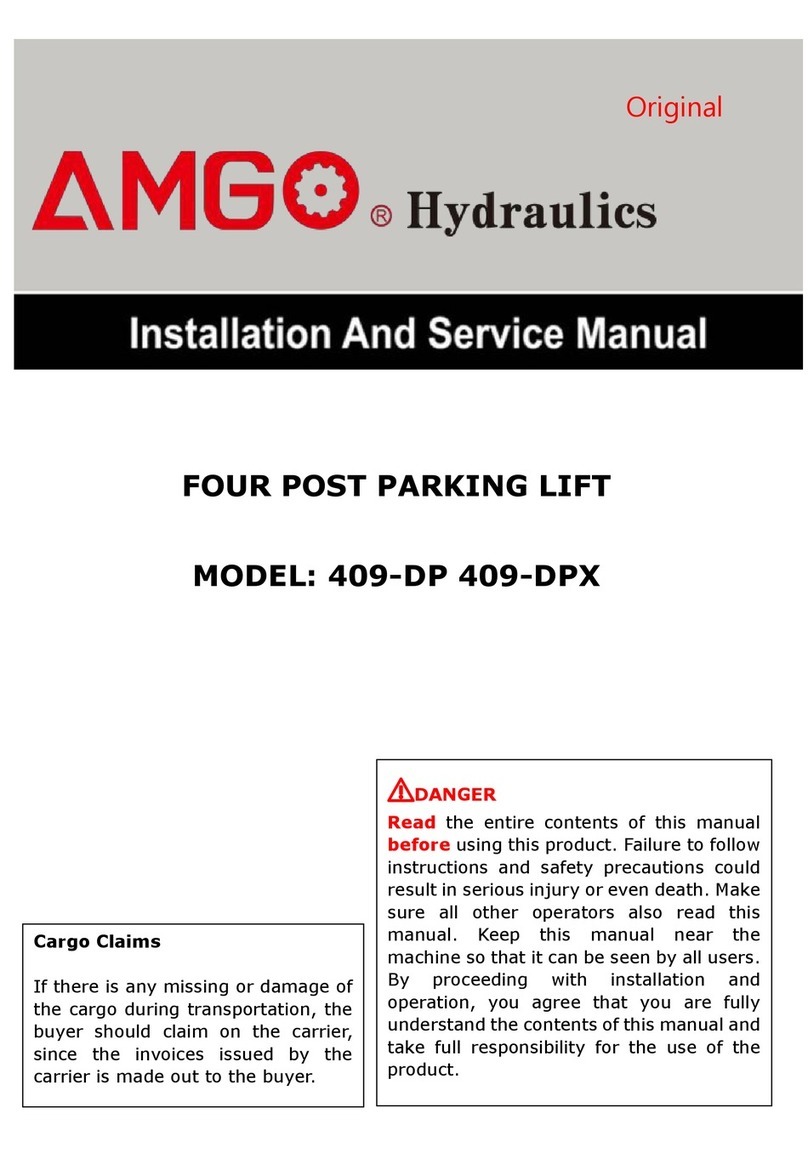
AMGO Hydraulics
AMGO Hydraulics 409-DP Installation and service manual

AAQ
AAQ AL-6214A Installation, operation, and parts manual

Joab
Joab Hookmaster manual
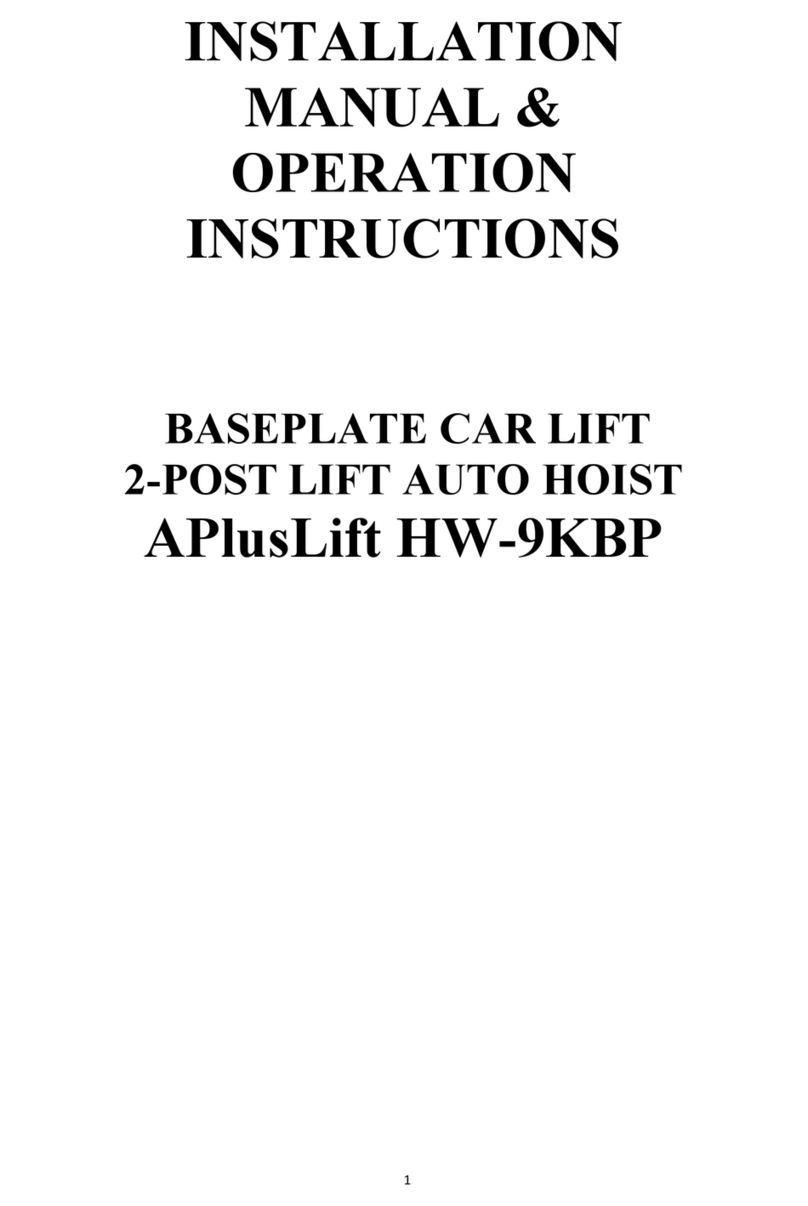
APlusLift
APlusLift HW-9KBP Installation manual & operation instructions
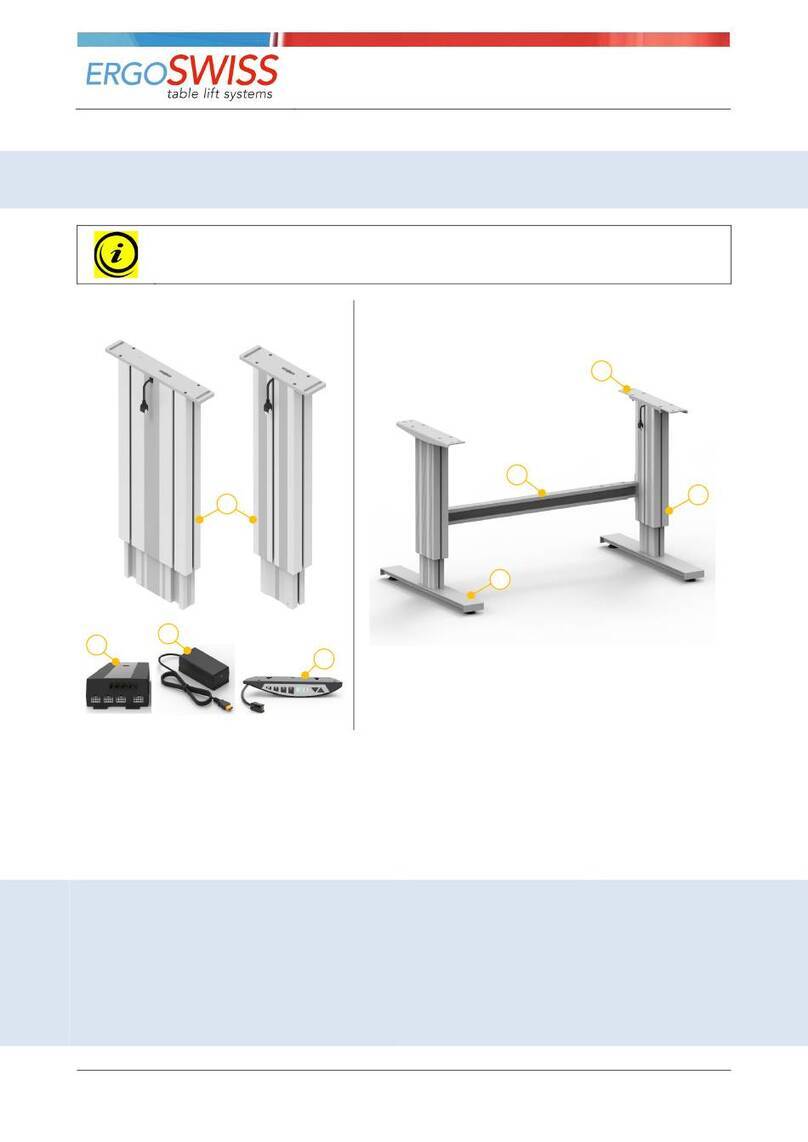
Ergoswiss
Ergoswiss SL 14 Compact Series Operating instruction

